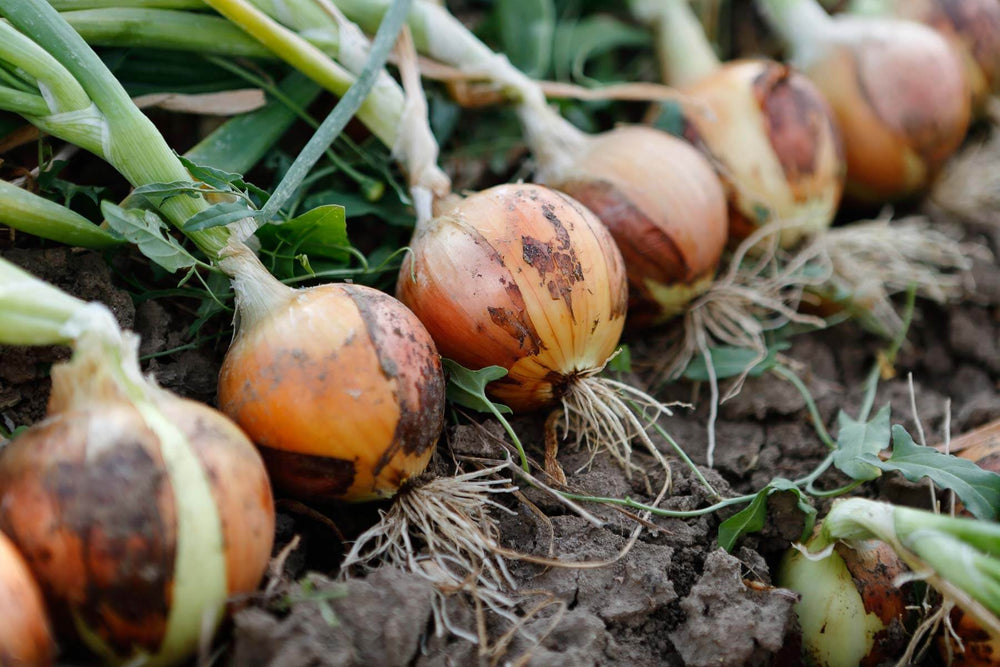Growing onions is simple: If you can poke a hole into the ground, you can grow an onion from a little plant. Most of our onion varieties are sold as little seedlings in bare-root bundles; each plant will start growing within days after you plant. If you can't plant your onions right away, remove their bindings and place them in a bucket with 2 inches of moist soil in the bottom. Keep them in a cool, bright place but out of direct sun until you are ready to plant. A sunny basement is ideal.
Quick Guide to Growing Onions
- Plant onions in early spring once the ground is workable. In-ground gardens and raised beds are both excellent options for growing onions.
- Space onion plants 6 inches apart in rows that are 12 inches apart. Grow them in a sunny spot that has fertile, well-drained soil with a pH of 6.0 to 6.8.
- Improve your native soil by mixing in several inches of aged compost or other rich organic matter.
- Onions aren't great at taking up water, so it's important to keep soil moist so their shallow roots can drink up. Water whenever the top inch of soil becomes dry.
- For best results, keep your growing onions fed with a continuous-release plant food.
- Onions can be eaten at nearly any size so harvest when they're the right size for your next culinary creation.
Soil, Planting, and Care
Most gardeners want sweet onions, and the sweetness of an onion is determined by both nature and nurture. For the mildest onions, start with a variety known to produce sweet, mild-flavored bulbs such as Texas Sweet (at southern latitudes) or Walla Walla (at northern latitudes). For great results, start with Bonnie Plants® onion slips, strong plants grown by a company that has been helping home gardeners for over a century.
Growing onions requires abundant sun and good drainage, and they grow best when the soil pH ranges between 6.0 and 6.8. Raised beds or raised rows made by mounding up soil are ideal, especially if your soil is heavy clay. Fill raised beds with a soil designed to be just the right weight and texture for raised beds, such as Miracle-Gro® Performance Organics® Raised Bed Mix. For mounded rows, mix a 3-inch layer of compost or aged compost-enriched Miracle-Gro® Performance Organics® All Purpose In-Ground Soil into the top 6 inches of soil. Set plants 1 inch deep, so that their roots are well covered with soil but the top of the plant's neck is not buried too deeply. You don't want the part of the neck where the leaves grow away from the clear sheath to collect soil or water down between the young leaves, or they can rot. Space plants 6 inches apart in furrows 12 inches apart. Plants grow best when, in addition to being grown in top-quality soil, they're fed with just the right plant food. To ensure growing onions get all the nutrition they need, feed regularly throughout the season with Miracle-Gro® Performance Organics® Edibles Plant Nutrition Granules, following label directions.
Onions roots are shallow and not very efficient at taking up moisture, so they need a steady supply of water to grow without interruption. Although they actually recover well from drought and start growing again when watered, it is best to keep the soil consistently moist until the bulbs enlarge.
You may mulch with a light layer of weed-free and herbicide-free grass clippings or another fine mulch. Onions naturally push toward the surface as they form bulbs, and it's best if the tops of the bulbs are allowed to bask in dry sun. Remove mulch that might keep the expanding bulbs excessively moist.
Seedlings that are about the diameter of a pencil produce the biggest, most beautiful bulbs, so some gardeners sort seedlings by size before planting. Plant the largest ones together only 2 inches apart to start enjoying as green onions in just two or three weeks. Very small seedlings set at close spacing can serve as a second crop of scallions. Use the pencil-sized plants to grow full-sized onions that will produce extra-juicy slices.
Troubleshooting
As onions leaves expand, they may be found by tiny black onion thrips, which suck sap from onion leaves. These are hard to see because they hide down in the folds and neck of the leaves. Also be on the lookout for aphids. Finally, weak plants that slowly wilt may be infested with onion root maggots, the larvae of a common fly. Contact your regional Extension agency for details on how to control these pests.
Harvest and Storage
You can harvest young onions just a few weeks after planting if you want to use them as "spring onions" or scallions. There is no perfect size, just pull when they are big enough to suit you.
For full-sized bulbs, let onions grow and mature. They are ready to harvest when the bulbs are big and the tops begin to turn yellow and fall over. Pull them up, shake off the soil, and lay them out to cure with the tops still attached. Any warm, airy location is a good place to do this; you can even sling them over a fence as long as they aren't rained upon. Bulbs must stay dry and have good air circulation. As the onions cure, the roots will shrivel and the necks above the bulbs will slowly dry – a natural process that helps to seal the top of the bulb, making the onions less likely to rot. After 7 to 10 days, clip off the tops of the onions and the roots with pruning shears, remove as much dry dirt as possible without taking off the papery outer skins, and store your onions in a cool place. Very sweet, juicy onions may be stored, wrapped in newspaper or paper towels, in the fridge.








 Herbs
Herbs
 Vegetables
Vegetables
 Fruit
Fruit
 Flowers
Flowers
 Succulents
Succulents

